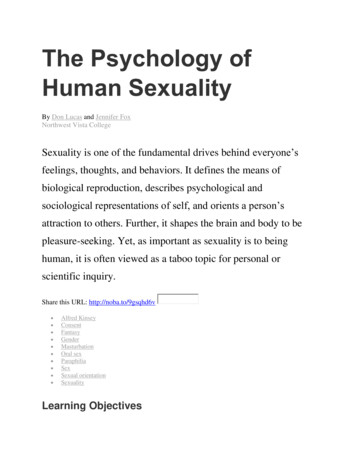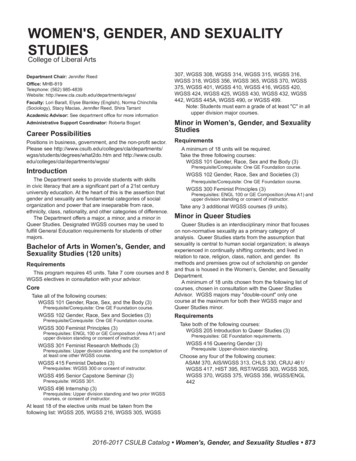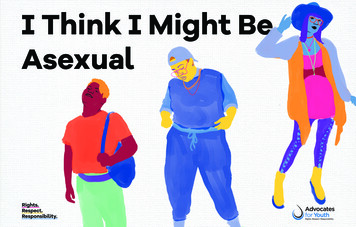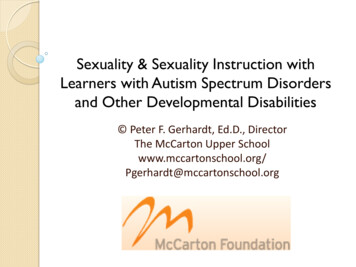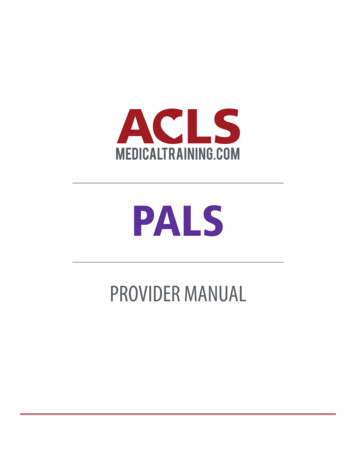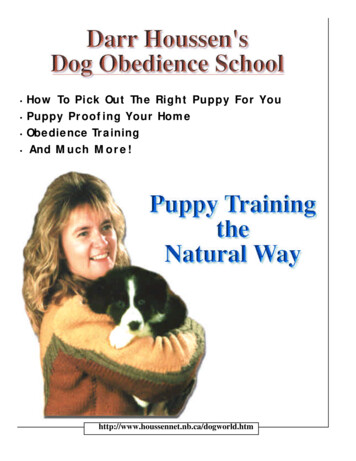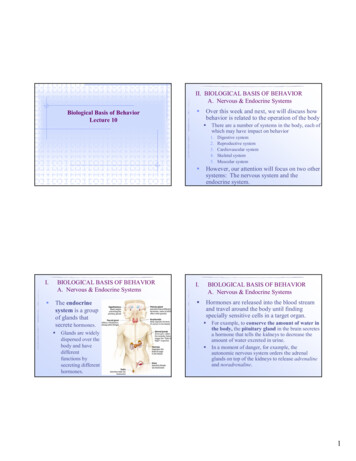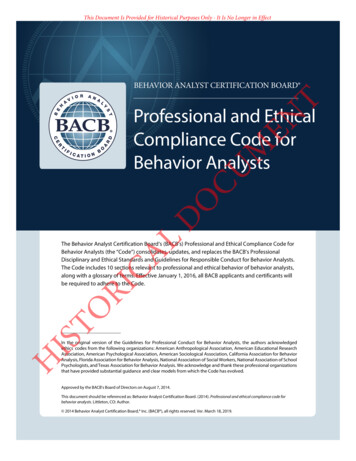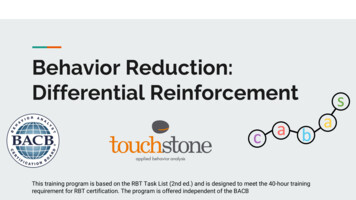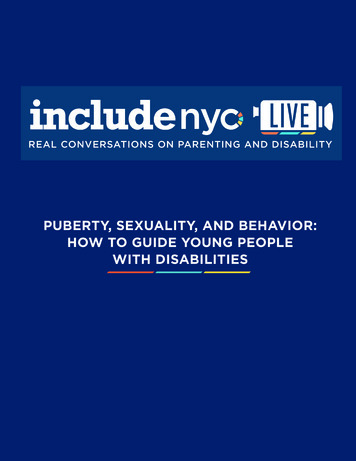
Transcription
PUBERTY, SEXUALITY, AND BEHAVIOR:HOW TO GUIDE YOUNG PEOPLEWITH DISABILITIES
RESOURCES ON SEXUALITY & SEX EDUCATIONFOR INDIVIDUALS WITH DISABILITIES(AND THEIR PARENTS/CAREGIVERS)Books Teaching Children with Down Syndrome about Their Bodies,Boundaries, and Sexuality: A Guide for Parents and Professionalsby Terri Couwenhoven (2007)Boyfriends and Girlfriends: A Guide to Dating for People withDisabilities by Terri Couwenhoven (2015) - Written at a 3rd gradereading level. Great to read together!Sexuality: Your Sons and Daughters with Intellectual Disabilities byMelberg Schwier and Dave Hingsburger (2000)Taking Care of Myself: A Hygiene, Puberty and Personal Curriculumfor Young People with Autism by Mary Wrobel (2003)Sexuality and Relationship Education for Children and Adolescentswith Autism-Spectrum Disorders: A Professional’s Guide toUnderstanding, Preventing Issues, Supporting Sexuality andResponding to Inappropriate Behaviors by Davida Hartmann (2014)Online Resources Center for Parent Information & Resources, Sexuality Education forStudents with Disabilities: y - Sexual Education Resources: http://bit.ly/2K9HPUbAutism Speaks - Sexuality Education for Children and Adolescentswith Developmental Disabilities: An Instructional Manual for Parentsor Caregivers of and Individuals with Developmental Disabilities(Florida Developmental Disabilities Council, Inc.):http://bit.ly/2wAG00HPlanned Parenthood - Information and resources for parents:http://bit.ly/2wqvb10Kids Health: www.kidshealth.orgInner Learning Online: www.innerbody.comSexEd Library by the Sexuality Education and Information Councilof the United States (SIECUS): www.sexedlibrary.org
Puberty, Behavior &SexualityTips & Techniques for Support1
Values Exercise10/10/201722
Fact or Fiction?People with disabilities do not feel the desire to have sex (if disabledin one way disabled in every way)People with developmental and physical disabilities are asexual,childlike, sexually innocent (do not possess maturity to learn aboutsexuality)People with disabilities are sexually impulsive (oversexed and unableto control their sexual urges) men aggressive & women promiscuousPeople with disabilities will not marry or have children so they haveno need to learn about sexuality10/10/201733
Sex shhh How much detail must I tell her? Won’t she just get confused? Is it really necessary to broach the subject of intercourse sinceJohnnie is simply not capable of a close relationship, let alone asexual encounter. Besides, he’ll be accompanied all his life by asupport worker, so what chance is there that he will have sex? Ronda is non verbal—how can I possibly teach her informationrelated to relationships, and what is the chance that she wouldeven understand it? Joey has a severe developmental disability and will be child-likefor the rest of his life. He won’t need that type of information. Bobbie is still young, there is a lot of time to think about teachinghim this type of information in five years or even later. What has"sex" or "sexuality" got to do with him now?4
What is Sexuality?
Social phenomenon (sociological)– Friendship– Warmth– Approval– Affection– Social outlets– Spiritual– Hygiene– dress What we feel about ourselves (psychological)– Whether we like ourselves– Our understanding of ourselves as men and women (genderidentification)– What we feel we have to share with others Having a physical sexual relationship (biological/physical)– Physical sensations or drives our bodies experience– Genital activity is one small part of human sexuality10/10/20176
Harmful Effects of Repression ofSexual Expression Emotional instability Sex related physicalproblems Anger Frustration and confusion Heightened anxiety Verbal/physicalaggression Physical discomfort Social-sexual misconduct Mental health problems Develop poor self esteemPoor decision makingFeelings of lonelinessIsolationAt-Risk behaviorCriminal behaviorLack of impulse controlInferiority complex (beingtold they are bad/evil) Depression
Adolescent Brain DevelopmentID/DDWITHOUT ID/DDBIOLOGICALPuberty dev’t the samePuberty dev’t the sameEMOTIONAL/SOCIALMood swingsSocial-sexual changesMood swingsSocial-sexual changesDIFFERENCE IS IN COGNITIONMore challenging to express feelingsNeed more concrete languageMore variety of ways to express feelingsMay understand more complex language10/10/20178
What is PubertyPuberty is the time in lifewhen a young person startsto become sexually mature.10/10/20179
Puberty: Physical Development FEMALE MALE8-11yrs- Usually begins 9-12 yrs- Usually begins 11-12yrs- Breast Growth, Height andWeight Gain.12-13yrs- Testicles & ScrotumBegin Enlarging.12-13yrs- Breast Growth cont.,Vagina is Enlarging,Produces Discharge as aCleansing Process.13-14yrs- Penis Begins to Growin Length, Hair, Height,and Voice Changes.13-14yrs- Pubic Hair Growth.14-15yrs- Dev’t continues 15yrs- Final Stages of Dev’t,Menstrual Period andOvulation Have UsuallyBegun.16 yrs- Nearing Adult Appearance10/10/201710
Puberty: Social & EmotionalDevelopment. During adolescence, you’ll notice changes in theway your child interacts with family, friends andpeers. Every child’s social and emotional development isdifferent. Your child’s development is shaped by your child’sunique combination of genes, brain development,environment, experiences with family and friends,and community and culture.10/10/201711
Puberty: Social & EmotionalDevelopment Social changes and emotional changes showthat your child is forming an independent identityand learning to be an adult. Remember that the rate of social and emotionaldevelopment varies widely, both for typicallydeveloping children and children with a disability.10/10/201712
Puberty: Social and EmotionalDevelopment Have difficulties monitoring and expressing emotions Difficulties with peer and social relationships Might have difficulties making and keeping friends Moodiness, has more arguments with you Sees things differently from you Antisocial behavior and risk-taking behavior Difficulties balancing emotions and behavior Wants to spend less time with family10/10/201713
So What May I See? Sees things differently from you Antisocial behavior and risk-takingbehavior Might have difficulties monitoringand expressing emotions Difficulties with peer and socialrelationships Might have difficulties making andkeeping friends Moodiness, has more argumentswith youDifficulties balancing emotions andbehaviorWants to spend less time withfamily10/10/201714
10/10/201715
Where do I start? What do I know?What do I still need to know?Where can I find information?Who else can help me? What information does my child alreadyhave? What information does my child need? How quickly is the information needed?10/10/201716
Where Do You Want Your Childto Learn About Sexuality?– Peers– Media– School– Parents– Internet10/10/201717
Why Social-Sexual Education? Decreases the Likelihood of Abuse. Combats Myths & Misinformation. Promotes Social Skills, Personhood,Pleasure. Reduces Fear, Anxiety, Worry. Increases Self-Awareness, Gender Comfort. Allows for Maturity, and HealthyRelationships.10/10/201718
Mild IDD Similar to average or normative psychosocial-sexual behavior insociety. Explores, adapts, and controls sexual impulses and urges in similarways as majority of society. Responds to verbal mode of sex education/sex counseling/sextherapy. Capable of developing appropriate adaptive skills with current sexeducation/counseling/therapy methods
Moderate IDD Secondary sexual characteristics may be delayed. Functions more on a primary reward and basicreinforcement system level. May respond to verbal mode of sexeducation/counseling to develop more appropriateadaptive behavior; however, may require techniques ofbehavior modification systems to be effective.
Severe/Profound IDD Very poor control of sexualimpulses. Functions primarily by havingbasic needs met. Lack of development ofadaptive psychosocial-sexualbehavior. Predominant reactions areimpulsive. Problems comprehendingsocietal rules, especiallyprivate vs public, anddeveloping adaptive behaviorsin these areas. The technique of behaviormodification may be mosteffective in affecting change inthis group Limited ability to predict orforesee consequences ofsensual/sexual behavior. Pleasure seeking frequently inself-stimulating. Often masturbates excessivelyor in a harmful wayunknowingly.
CHALLENGES People with disabilities may have:––––Difficulty learningLimited genital and other tactile sensationsCommunication problemsUncertainty about their sexual function and fertility status Issues that may hinder development of healthy bodyimage and self-concept include:–––––Use of braces, crutches, wheelchairBladder and bowl management routinesPhysical differences from peers (atrophy)Diminished gender role expectations from societyMistrust of own body10/10/201722
Socialization Children with disabilities have:– -Fewer opportunities than their peers to observe, develop andengage in appropriate social and sexual behavior– -Fewer opportunities to acquire information from peers -Often held back by social isolation as well as functionallimitations . By fostering development of social skills, parents andeducators can provide opportunities to learn about thesocial contexts of sexuality and the responsibilities ofexploring and experiencing ones own sexuality.23
Socialization National Dissemination Center for Children withDisabilities (NICHCY) recommends:– Helping children develop hobbies and pursueinterests or recreational activities in the communityand after school– Children with disabilities should engage in socialopportunities and to grow and learn from social errors– Extra-curricular activities present opportunities forfriendship based on commonality of interests andprovide opportunities to develop competence andself-esteem
Why “Behaviors”? Inappropriate sexual behavior by individuals with disabilities can stem from:– Lack of opportunity for appropriate sexual expression– Ignorance of what is considered appropriate behavior– Poor social education Behavior that leads teens with disabilities into trouble as perpetrators maynot necessarily be atypical for adolescents but it also involves either badjudgment on the part of the person with a disability or a hasty reaction onpart of parents, school, employer. Opportunities for privacy are less frequent for people with special needs Comprehensive sexuality education often withheld from this population Not surprising that teens with disabilities display sexuality inappropriately Whether sexual behavior is considered appropriate depends on the locationin which the behavior takes place – need to look at problematic behavior inits context10/10/201725
Issues Problems most frequently mentioned by parentsregarding sexuality education are:– Inability to answer questions– Uncertain of what children know or should know– Confusion, anxiety and ambivalent attitudes towardsexuality of their children– Equate learning with intentions to perform sexualactivities10/10/201726
Parents as Sex Educators Parents of children with developmental disabilities tendto be uncertain about the appropriate management oftheir child’s sexual development Concerned about–––––––Overt signs of sexualityPhysical development during pubertyGenital hygieneFears of unwanted pregnancySTI’sEmbarrassing or hurtful situationsFear that their child will be unable to express sexual impulsesappropriately– Targets of sexual abuse or exploitation10/10/201727
Parents are the First SexEducators Parents need to help their child develop life skills Without appropriate social skills young peoplemay have difficulty making and keeping friendsand may feel lonely and different. Without important sexual health knowledge,young people may make unwise decisions andor take sexual health risks.10/10/201728
Self-touch Sexual self-stimulation or masturbation is normal, naturaland non-harmful behavior throughout the life cycle Self-stimulation can be a way of learning to be morecomfortable with and/or enjoying one’s sexuality bygetting to know one’s body Self-stimulation is a private behavior and inappropriate inpublic places10/10/201729
Public vs. Private People with disabilities are capable of learning how to act appropriately inpublic and private places– Many inappropriate actions and activities reflect confusion, lack ofawareness and limited judgment Many social problems indicate a limited understanding about public andprivate places, private parts of the anatomy and public and privatebehaviors.– Discouraged from public engaging in activities such as: Exposing private parts of the anatomy by undressing, pulling downor lifting up clothing Scratching or touching genitals Fixing or adjusting underclothing Self-stimulation10/10/201730
General Guidelines for Parents Be clear when discussing relationships (mother fathervs, Paul and Carol) Use teachable moments that arise in daily life (e.g.,friends pregnancy, marriage, adoption) Be honest when children ask you questions Always acknowledge and value your child’s feelings andexperience. Be willing to repeat information over time – don’t expectyour child to remember everything you said10/10/201731
General Guidelines for Parents Be able to talk about and ask questions about sexualityrelated issues Prepare for puberty (parent & pre-adolescent)– Male vs. female body parts (correct names, changes)– Menstruation– Care of genitals & general body care Use pictures in communication/teaching Seek out/ask for support10/10/201732
General Guidelines for Parents Be ready to assert your personal privacy boundaries Use accurate language for body parts and bodilyfunctions.– Children with accurate language are more likely toreport abuse if it occurs10/10/201733
It’s Not Just About Sex! Social Concepts (Friendships, Social Skills) are as Important asSexual Concepts (Masturbation, Pregnancy Prevention). Be Proactive, Not Reactive: Teach the Concepts Before the IssuePresents Itself! Stay Neutral; Avoid Judgment. Model Appropriate Boundaries by choosing Private Locations toDiscuss Topics and/or Issues. Use Repetition, Especially with Key Concepts. Teach Complex Tasks in Simpler, Individual Steps, and InChronological Order.10/10/201734
So What to Teach? Private vs. PublicBoundariesGood touch/bad touchHidden Social EtiquetteTeach concretely, especially abstractconcepts. Time and Place Social-Sexual Education (curriculum)10/10/201735
What to Teach? Body ImageSelf-EsteemBeing HealthyHygienePubertySocial SkillsPrivate vs. PublicSexual OrientationMenstruationAbuse PreventionMasturbationRelationships & BoundariesSTDs, Birth Control, Pregnancy10/10/201736
Parents as the first SocialSexual Educators Normalize the Discussion of Sexuality! Use concrete language at their cognitive level & pictures. Making it Taboo Encourages Secrecy and Increases Vulnerability. You may need to initiate the conversation! Be honest and give correct information. Respond to All Sexual Issues Non-Judgmentally. If Necessary, Refer Loved Ones for Additional Services related toSexuality, such as Sexuality Training, Psychotherapy, or ConsentDetermination.10/10/201737
Social Stories
Goals of Sex Education for People with Disabilities1. To help people with disabilities communicate about sexuality with others withoutunnecessary guilt or embarrassment in relations to their sexual orientation, theirsexual interests and/or activities.2. To provide accurate sexuality information at cognitively appropriate levels usingmulti-sensory modes of communication such as pictures, models, role plays, videos,etc.3. To teach awareness about the body which allows people with disabilities to seethemselves to be like others. This generates self-confidence which in turn, willheighten self-esteem.4.To help make it possible for people with disabilities to enjoy the company offriends by acquiring social skills; and developing positive relationship with others5. To actively involve the student in the learning process.45
Goals of Sex Education for People with Disabilities6.To help people learn the responsibilities of being a sexual person includingcustomary social patterns.7.To train people so they will avoid situations where they could be sexuallyexploited, harmed or abused.8.To teach people to avoid unsafe or illegal sexual behavior.9.To help prevent the overprotection that arises from fear of procreation byoffering people information about, and help with, birth control.10. To teach skills that will enable individuals to make responsible choices and dealmore effectively with the challenges they may encounter throughout their lives.46
Education and training arethe key to promoting healthyand mutually respectfulbehavior regardless ofdisability.10/10/20174747
Reference1. Byers, E.S., Sears, H.A., & Weaver, A.D. (2008). Parents’ reports of sexual communication with children in kindergarten tograde 8. Journal of Marriage and Family, 10(February), 86-96.2. Wilson, E.K., Dalberth, B.T., Koo, H.P., & Gard, J.C. (2010). Parents’ perspectives on talking to preteen age children aboutsex. Perspectives on Sexual and Reproductive Health, 42(1), 56-63.3. SIECCAN. (2010). Sexual Education in Schools: Questions & Answers, 3rd Ed.4. SIECCAN. (2010). Sexual Education in Schools: Questions & Answers, 3rd Ed.5. Alberta Education (2002). Health and Life Skills, Program of Studies.6. Alberta Health Services, Calgary Zone, Sexual & Repoductive Health. (2010). Get the facts on teen pregnancy, sexuallytransmitted infections (STI), HIV & AIDS, and teen sexuality. Calgary: Author.7. SIECCAN. (2010). Sexual Education in Schools: Questions & Answers, 3rd Ed.8. SIECCAN. (2010). Sexual Education in Schools: Questions & Answers, 3rd Ed.9. Public Health Agency of Canada. (2003). Canadian Guidelines for Sexual Health Education. Ottawa.*49
Reference 6. Alberta Health Services, Calgary Zone, Sexual & Repoductive Health. (2010).Get the facts on teen pregnancy, sexually transmitted infections (STI), HIV &AIDS, and teen sexuality. Calgary: Author. 7. SIECCAN. (2010). Sexual Education in Schools: Questions & Answers, 3rd Ed. 8. SIECCAN. (2010). Sexual Education in Schools: Questions & Answers, 3rd Ed. 9. Public Health Agency of Canada. (2003). Canadian Guidelines for SexualHealth Education. Ottawa.50
Join us for monthly series of live streamed, interactive onlineworkshops on a wide variety of disability topics.Below is an archive of all of our past episodes with resourcesyou can use to follow along.You can also register for an upcoming episode here.Disability vs. Language Barrier for EnglishLanguage LearnersVideo ResourcesPositive Supports for Young Children withChallenging BehaviorsVideo ResourcesApplied Behavior Analysis (ABA) for Infants andToddlers with AutismVideo ResourcesHow to Talk to Your Child About BullyingVideo ResourcesSupported Decision Making - Alternative toGuardianship for People with DisabilitiesVideo ResourcesFrom School to WorkVideo ResourcesHow to Get Assistive Technology on Your Child's IEPVideo ResourcesMoving from Early Intervention to Preschool ServicesVideo ResourcesAutism & WanderingVideo Resources
Accessibility for Young People with Disabilitiesin NYC SchoolsVideo ResourcesLife Planning for Families of Loved Oneswith DisabilitiesVideo ResourcesKindergarten for Children with Autism SpectrumDisorderVideo ResourcesStudent-led Individualized Education Program (IEP)ProcessVideo ResourcesGet the Special Education Services You WantThrough MediationVideo ResourcesDiscover how accessible reading materials workfor students with disabilitiesVideo ResourcesAsk an Expert: Special EducationVideoIndependence & Travel TrainingVideo Resources
love, equity, & access for young people with disabilitiesIs your child struggling in school?Does your child havespecial needs or an IEP?Do you have questions about youryoung person with a disability?WE CAN HELP FOR FREEINCLUDEnyc provides one-to-one help, information resources,and workshops on topics that are important to you, at no cost.CALL US(212) 677-4660TEXT US(646) 693-3175VISIT INCLUDEnyc.orgFOR INFORMATIONAND UPCOMING WORKSHOPS
amor, equidad, y acceso para jovenes con discapacidades¿Su hijo tiene problemas en la escuela?¿Su hijo tiene un IEP(Programa de Educación Individualizada)?¿No sabe cómo ayudar a su hijo connecesidades especiales?NOSOTROS LO PODEMOSAYUDAR GRATUITAMENTEINCLUYEnyc proporciona ayuda individualizada, recursos de información,y talleres gratuitos sobre temas que son importantes para usted.LLÁMENOS(212) 677-4668ENVÍE UN MENSAJE DE TEXTO(646) 693-3157VISITE INCLUYEnyc.orgINFORMACIÓN, RECURSOS Y TALLERES
RESOURCES ON SEXUALITY & SEX EDUCATION FOR INDIVIDUALS WITH DISABILITIES (AND THEIR PARENTS/CAREGIVERS) Books Teaching Children with Down Syndrome about Their Bodies, Boundaries, and Sexuality: A Guide for Parents and Professionals by Terri Couwenhoven (2007) Boyf

